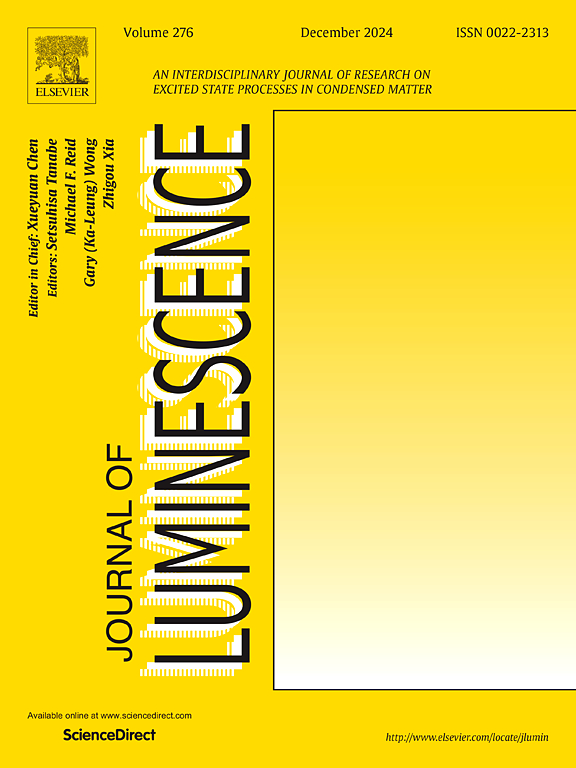Achieving blue light excitation and broadband NIR-II region emission regulation of ALaMgSbO6: Ni2+ (A=Ca, Sr, Ba) phosphors
IF 3.3
3区 物理与天体物理
Q2 OPTICS
引用次数: 0
Abstract
Obtaining broadband near-infrared (NIR) II region phosphors that can be effectively excited by blue light chips remains a significant challenge in the current construction of compact NIR light sources. In this work, a novel series of Ni2+-activated ALaMgSbO6 (A = Ca, Sr, Ba) double perovskite phosphors were designed and synthesized. By substituting the A-site ions, tunable broadband emission of Ni2+ in the NIR-II region was achieved. Experiments and theoretical calculations show that A-site substitution and Ni2+ doping have a certain impact on the luminescence performance. When the A-site was occupied by Ca2+, the CaLaMgSbO6: 1.2 % Ni2+ phosphor showed the highest emission intensity. Under 440 nm blue light excitation, CaLaMgSbO6: 1.2 % Ni2+ achieved long-wavelength broadband NIR emission centered at 1546 nm with a full width at half maximum (FWHM) of 229 nm and photoluminescence quantum yield of 32.94 %. Finally, CaLaMgSbO6: 1.2 % Ni2+ phosphor was coated on a 440 nm blue light chip to package NIR-LED, verifying its feasibility in material detection and night vision. These results have opened up new ways to develop efficient broadband NIR-II region LED light sources.
实现ALaMgSbO6: Ni2+ (A=Ca, Sr, Ba)荧光粉的蓝光激发和宽带NIR-II区发射调控
获得可被蓝光芯片有效激发的宽带近红外(NIR) II区荧光粉仍然是当前紧凑型近红外光源构建中的一个重大挑战。本文设计并合成了一种新型的Ni2+活化ALaMgSbO6 (a = Ca, Sr, Ba)双钙钛矿荧光粉。通过取代a位离子,在NIR-II区实现了Ni2+的可调谐宽带发射。实验和理论计算表明,a位取代和Ni2+掺杂对发光性能有一定的影响。当Ca2+占据a位时,CaLaMgSbO6: 1.2% Ni2+发光强度最高。在440 nm蓝光激发下,CaLaMgSbO6: 1.2% Ni2+实现了以1546 nm为中心的长波宽带近红外发射,半峰宽(FWHM)为229 nm,光致发光量子产率为32.94%。最后,将CaLaMgSbO6: 1.2% Ni2+荧光粉涂覆在440 nm蓝光芯片上封装NIR-LED,验证了其在材料检测和夜视方面的可行性。这些结果为开发高效宽带NIR-II区域LED光源开辟了新的途径。
本文章由计算机程序翻译,如有差异,请以英文原文为准。
求助全文
约1分钟内获得全文
求助全文
来源期刊

Journal of Luminescence
物理-光学
CiteScore
6.70
自引率
13.90%
发文量
850
审稿时长
3.8 months
期刊介绍:
The purpose of the Journal of Luminescence is to provide a means of communication between scientists in different disciplines who share a common interest in the electronic excited states of molecular, ionic and covalent systems, whether crystalline, amorphous, or liquid.
We invite original papers and reviews on such subjects as: exciton and polariton dynamics, dynamics of localized excited states, energy and charge transport in ordered and disordered systems, radiative and non-radiative recombination, relaxation processes, vibronic interactions in electronic excited states, photochemistry in condensed systems, excited state resonance, double resonance, spin dynamics, selective excitation spectroscopy, hole burning, coherent processes in excited states, (e.g. coherent optical transients, photon echoes, transient gratings), multiphoton processes, optical bistability, photochromism, and new techniques for the study of excited states. This list is not intended to be exhaustive. Papers in the traditional areas of optical spectroscopy (absorption, MCD, luminescence, Raman scattering) are welcome. Papers on applications (phosphors, scintillators, electro- and cathodo-luminescence, radiography, bioimaging, solar energy, energy conversion, etc.) are also welcome if they present results of scientific, rather than only technological interest. However, papers containing purely theoretical results, not related to phenomena in the excited states, as well as papers using luminescence spectroscopy to perform routine analytical chemistry or biochemistry procedures, are outside the scope of the journal. Some exceptions will be possible at the discretion of the editors.
 求助内容:
求助内容: 应助结果提醒方式:
应助结果提醒方式:


